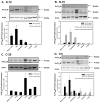Serotonin 5-HT2C receptor protein expression is enriched in synaptosomal and post-synaptic compartments of rat cortex
- PMID: 20345755
- PMCID: PMC2917206
- DOI: 10.1111/j.1471-4159.2010.06694.x
Serotonin 5-HT2C receptor protein expression is enriched in synaptosomal and post-synaptic compartments of rat cortex
Abstract
The action of serotonin (5-HT) at the 5-HT(2C) receptor (5-HT(2C)R) in cerebral cortex is emerging as a candidate modulator of neural processes that mediate core phenotypic facets of several psychiatric and neurological disorders. However, our understanding of the neurobiology of the cortical 5-HT(2C)R protein complex is currently limited. The goal of the present study was to explore the subcellular localization of the 5-HT(2C)R in synaptosomes and the post-synaptic density, an electron-dense thickening specialized for post-synaptic signaling and neuronal plasticity. Utilizing multiples tissues (brain, peripheral tissues), protein fractions (synaptosomal, post-synaptic density), and controls (peptide neutralization, 5-HT(2C)R stably-expressing cells), we established the selectivity of two commercially available 5-HT(2C)R antibodies and employed the antibodies in western blot and immunoprecipitation studies of prefrontal cortex (PFC) and motor cortex, two regions implicated in cognitive, emotional and motor dysfunction. For the first time, we demonstrated the expression of the 5-HT(2C)R in post-synaptic density-enriched fractions from both PFC and motor cortex. Co-immunoprecipitation studies revealed the presence of post-synaptic density-95 within the 5-HT(2C)R protein complex expressed in PFC and motor cortex. Taken together, these data support the hypothesis that the 5-HT(2C)R is localized within the post-synaptic thickening of synapses and is therefore positioned to directly modulate synaptic plasticity in cortical neurons.
Figures








References
-
- Abramowski D, Rigo M, Duc D, Hoyer D, Staufenbiel M. Localization of the 5-hydroxytryptamine2C receptor protein in human and rat brain using specific antisera. Neuropharmacology. 1995;34:1635–1645. - PubMed
-
- Abramowski D, Staufenbiel M. Identification of the 5-hydroxytryptamine2C receptor as a 60-kDa N-glycosylated protein in choroid plexus and hippocampus. J. Neurochem. 1995;65:782–790. - PubMed
-
- Backstrom JR, Westphal RS, Canton H, Sanders-Bush E. Identification of rat serotonin 5-HT2C receptors as glycoproteins containing N-linked oligosaccharides. Brain Res. Mol. Brain Res. 1995;33:311–318. - PubMed
Publication types
MeSH terms
Substances
Grants and funding
LinkOut - more resources
Full Text Sources
Miscellaneous

